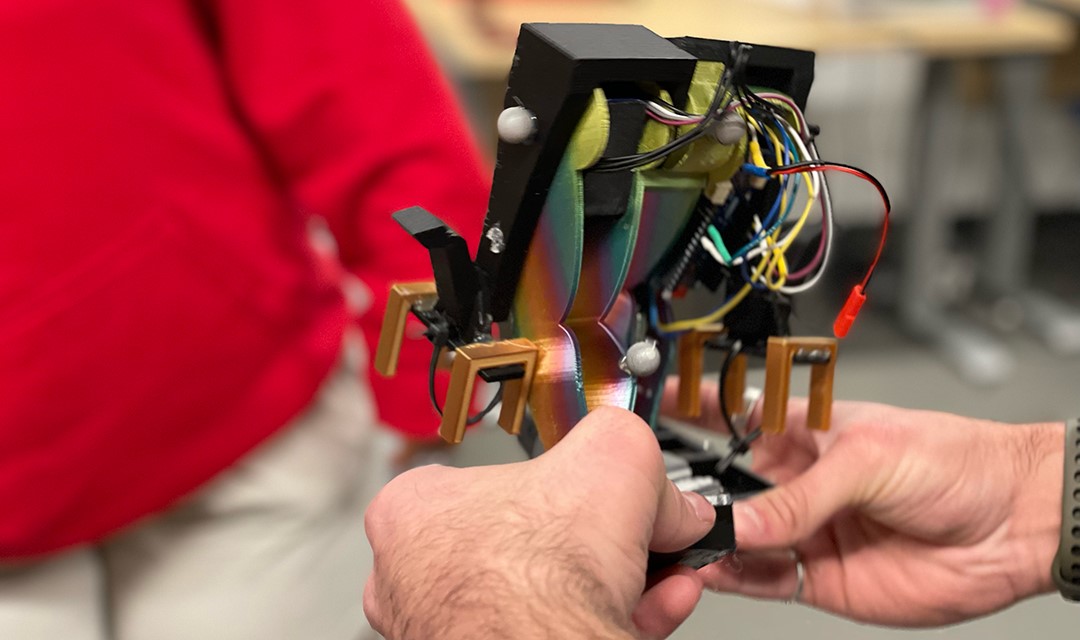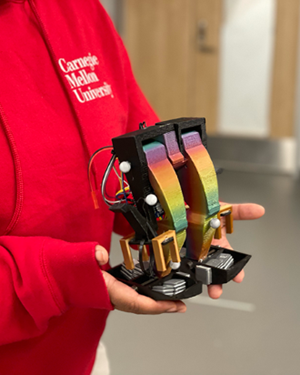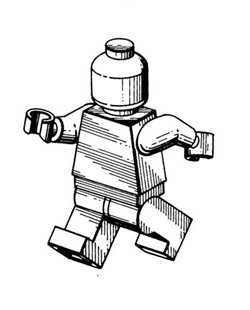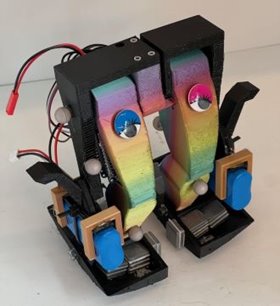From Minifig to Walking Mini-Robot
From Minifig to Walking Mini-Robot


After contemplating a Lego, researchers at Carnegie Mellon have developed a small robot with complex mobility.
Search and rescue teams have difficulty getting around rubble-strewn ruins to find survivors. The same is true in other disaster areas, from burned out buildings to war zones. Not only is the going tough, but they are often dangerous environments for human first responders.
Such scenarios and many others lend themselves to the advantages of search robots, which can perform those tasks without risking human lives in the process. Plus, robots can be designed to go into tighter and more confined spaces too constrained for humans or even search dogs to enter.
The challenge, however, is that often, small robots wind up being as mechanically complex as big ones. Shrinking complex servomotors and other mechanical systems to fit into a palm-sized form factor. A team of researchers at Carnegie Mellon University in Pittsburgh has developed a robot that takes a “step” toward simplicity. The team claims its Mugatu is the first steerable bipedal robot to operate with only a single motor.
“The one actuator is a servomotor that connects between the two legs at the hip joint, and the system uses passive dynamics to coordinate motion in other directions,” said Aaron M. Johnson, associate professor of mechanical engineering at Carnegie Mellon.
Johnson said the team had set its sights on a much smaller target when it started work on what would become Mugatu.
“The original goal of this project was actually to see if we can make a Lego mini figure that can actually walk,” Johnson said. “The small form factor would require a design that uses only one or two motors, given the limited space available.”
Lego minifigures (or minifigs) are typically 4 cm tall and consist of nine rigid plastic parts: a head, torso, and hips block, plus two arms, two hands, and two legs. Because each leg is made by injection molding as a single part, there is no actuation at the knee or ankle.
The simplicity of the toy’s design created a challenge for modelling how to make it walk. (There are animated Lego movies, but those don’t rely on actual physics.) “The design process focused on studying a class of systems known as ‘passive dynamic walkers,’ which have no motors and can walk down slopes,” Johnson said. These systems are typically very efficient as they can’t rely on motors to make their legs swing into the proper position to take a step, but they also need a force, such as gravity, to set them in motion.
“We distilled down a set of design principles that enable this robot to walk with just one motor,” Johnson said.
The key is the design of the feet. Unlike Lego minifigs, which have flat feet, Mugatu’s feet are rounded. Because of that, each step produces a side-to-side rocking motion that not only enables the legs to clear the floor as the robot walks but produces enough momentum to propel it forward.
“Through careful design and control, the robot is able to start and stop walking on its own as well as turn left or right, allowing it to explore anywhere in space,” Johnson said. “The steering is achieved by changing the speed of the motor when one leg is on the ground vs the other leg.”
The simplicity of the design means Mugatu can be efficient enough to rely on its own battery pack rather than external power. That’s an important milestone for robots intended to work in hard-to-reach areas.
“The simple design allows the robot to be small and will enable future work to make even smaller robots. Small mobile robots allow access to small spaces for industrial inspection or search and rescue,” Johnson said.
Even so, at 15 cm tall and weighing in at 800 g, no one will confuse Mugatu with a Lego minifig.
“We aren't quite at that size yet,” Johnson said, “but this simple design is an important step to get there.”
Jim Romeo is a technology writer in Chesapeake, Va.
Such scenarios and many others lend themselves to the advantages of search robots, which can perform those tasks without risking human lives in the process. Plus, robots can be designed to go into tighter and more confined spaces too constrained for humans or even search dogs to enter.
The challenge, however, is that often, small robots wind up being as mechanically complex as big ones. Shrinking complex servomotors and other mechanical systems to fit into a palm-sized form factor. A team of researchers at Carnegie Mellon University in Pittsburgh has developed a robot that takes a “step” toward simplicity. The team claims its Mugatu is the first steerable bipedal robot to operate with only a single motor.
“The one actuator is a servomotor that connects between the two legs at the hip joint, and the system uses passive dynamics to coordinate motion in other directions,” said Aaron M. Johnson, associate professor of mechanical engineering at Carnegie Mellon.
Johnson said the team had set its sights on a much smaller target when it started work on what would become Mugatu.
“The original goal of this project was actually to see if we can make a Lego mini figure that can actually walk,” Johnson said. “The small form factor would require a design that uses only one or two motors, given the limited space available.”
Lego minifigures (or minifigs) are typically 4 cm tall and consist of nine rigid plastic parts: a head, torso, and hips block, plus two arms, two hands, and two legs. Because each leg is made by injection molding as a single part, there is no actuation at the knee or ankle.
The simplicity of the toy’s design created a challenge for modelling how to make it walk. (There are animated Lego movies, but those don’t rely on actual physics.) “The design process focused on studying a class of systems known as ‘passive dynamic walkers,’ which have no motors and can walk down slopes,” Johnson said. These systems are typically very efficient as they can’t rely on motors to make their legs swing into the proper position to take a step, but they also need a force, such as gravity, to set them in motion.
“We distilled down a set of design principles that enable this robot to walk with just one motor,” Johnson said.
The key is the design of the feet. Unlike Lego minifigs, which have flat feet, Mugatu’s feet are rounded. Because of that, each step produces a side-to-side rocking motion that not only enables the legs to clear the floor as the robot walks but produces enough momentum to propel it forward.
“Through careful design and control, the robot is able to start and stop walking on its own as well as turn left or right, allowing it to explore anywhere in space,” Johnson said. “The steering is achieved by changing the speed of the motor when one leg is on the ground vs the other leg.”
The simplicity of the design means Mugatu can be efficient enough to rely on its own battery pack rather than external power. That’s an important milestone for robots intended to work in hard-to-reach areas.
“The simple design allows the robot to be small and will enable future work to make even smaller robots. Small mobile robots allow access to small spaces for industrial inspection or search and rescue,” Johnson said.
Even so, at 15 cm tall and weighing in at 800 g, no one will confuse Mugatu with a Lego minifig.
“We aren't quite at that size yet,” Johnson said, “but this simple design is an important step to get there.”
Jim Romeo is a technology writer in Chesapeake, Va.




